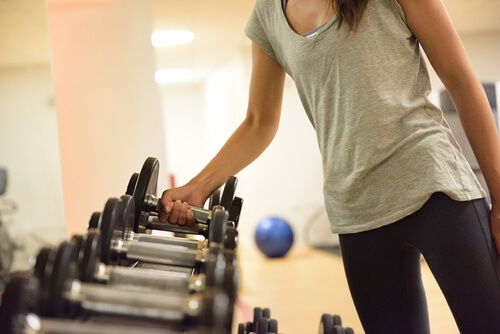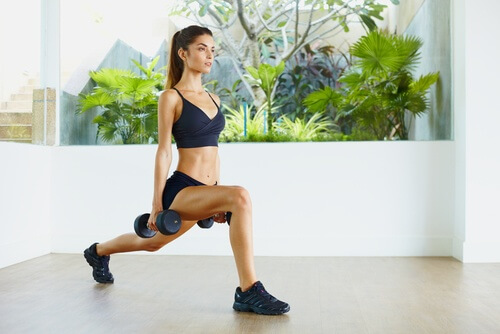What is Better When You Exercise: More Weight or More Repetitions?

We must opt for one alternative or the other depending on our objectives, since we need to use different routines for losing weight than for gaining muscle in certain areas. Anyone who goes to the gym or does exercise at home has certainly at one time or another asked the question: What is better when exercising? More weight or more repetitions?
Everything depends on what our objective is. To know more, keep reading this article.
Do I lift more weight or do more repetitions?

It could be said that this is the million dollar question, and that it is accompanied by other questions, such as what is the most effective method to strengthen and gain muscle or how do I lose weight faster.
- First of all we must know something very important: to progress in the gym and achieve our athletic and physical goals we cannot always train in the same way.
- This means that every few days it is essential to implement certain changes or improvements.
If we always lift the same weight, do the same number of repetitions or we run at the same speed, the body gets accustomed and reaches a “low” threshold or ceiling.
In this way it tells us that we’ve achieved our goal and that we don’t need to use more effort. Thus, the result or consequence of this habit is precisely not making any change or improvement.
Though the body is increasingly resistant to exercise (and that is also good news) we cannot stay “stuck” in the same routine. Because, what’s more, it’s very boring.
Variations are necessary because they allow us to improve and achieve our goals or at least get closer to them.
If we want to have more muscle, we will have to lift more and more weight than we are used to.
It doesn’t matter the number of repetitions we do, but rather the number of kilos that we can add to the bar or to the machine in question. Progress is very important, considering that the body gets accustomed.
But be careful, because this is not to say to strain yourself, as that can lead to muscle and joint injuries that, besides being painful, move us away from our goal.
It is not advisable to add a lot of weight at the same time but to go slowly.
More repetitions = more progress?
As for repetitions, maybe we have the “permission” to change them to our liking and even reduce the amount if we do more weight.
The problem is that, soon after, the body, becomes comfortable again (reaching a ceiling) and, if we do not introduce a change, we do not improve or move forward.
Instead of increasing the load, it is advisable to do more repetitions with the same weight. When that weight and those repetitions no longer represent a challenge to you, then modify one or the other variable.
Thanks to the repetitions you will be stronger, because you will develop the muscles and the organism will be more resistant to fatigue. In addition, you can burn more fat and calories.
The increase in repetitions does not always have to go hand in hand with an increase in weight; rather, you can alternate the changes.
A good technique for lifting weights consists of fewer loads, but more repetitions. Thus we focus on movement and avoid injuries caused by excessive weight without prior preparation.
It is recommended not to exceed 16 repetitions when lifting weights. If that seems low, then it is because you need to increase the weight.
In order to progress step by step, the important thing to alternate. As you can lift more weight you can increase the repetitions and vice versa.
We recommend you read: Use These 5 Tricks to Start Burning Calories Without Realizing It
To gain strength: more weight or more repetitions?

For this we must produce muscle damage, which leads to protein synthesis and the construction of muscle fibers (during the recovery process).
- Three factors influence this process: mechanical stress, metabolic stress and muscle damage.
- In order to develop muscle mass, we must perform between 3 and 5 sets of up to 12 repetitions with breaks of 1 to 3 minutes.
Strength and resistance are the other two pillars for which athletes aim.
The type of combination weight-series depends upon what we want to achieve.
- To build strength, between 4 and 8 sets of 1 to 3 repetitions at the maximum capacity that we can lift are recommended.
- On the other hand, to build resistance, loads must be lowered and repetitions increased (between 12 and 16).
Sessions with high loads increase strength, but this type of training can have its consequences and risks. For example, it causes injuries or negative adaptations.
Low loads are less “harmful”, but the results are smaller.
As long as they are done with planning and guidance, either of the two practices can be healthy.
See also: Guide and Remedies for Losing Weight
To burn fat: more weight or more repetitions?

This is another common question in gyms.
Although there are many myths related to this topic, the truth is that exercising with the proper weight and repetitions and increasing them every few weeks (according to our advances) is going in the right direction.
Many people relate burning calories with aerobic exercises (for example, the treadmill or the stationary bicycle) and not with a session of weightlifting.
The reality is that both can complement each other to achieve your weightloss goals.
It is not true either that we will reduce more fat by doing more repetitions. Everything depends on the intensity that we apply to the training.
- High loads and few repetitions result in more muscle mass and, therefore, less fat.
If we seek to burn calories and gain muscle, then it is better to do repetitions with a high weight rather than low.
However, if your only goal is to lose weight, then more sets with low loads are recommended.
All cited sources were thoroughly reviewed by our team to ensure their quality, reliability, currency, and validity. The bibliography of this article was considered reliable and of academic or scientific accuracy.
- Kraemer, W. J., & Spiering, B. A. (2008). Crecimiento muscular. National Strength & Conditioning Association. https://www.esi.academy/wp-content/uploads/Crecimiento-muscular.pdf
- Schoenfeld, B. J., Contreras, B., Krieger, J., Grgic, J., Delcastillo, K., Belliard, R., & Alto, A. (2019). Resistance Training Volume Enhances Muscle Hypertrophy but Not Strength in Trained Men. Medicine and science in sports and exercise, 51(1), 94–103. https://doi.org/10.1249/MSS.0000000000001764
- Taber, C.B., Vigotsky, A., Nuckols, G. et al. Exercise-Induced Myofibrillar Hypertrophy is a Contributory Cause of Gains in Muscle Strength. Sports Med 49, 993–997 (2019). https://doi.org/10.1007/s40279-019-01107-8
- Ángeles Carbajal Azcona. Manual de Nutrición y Dietética. Universidad Complutense de Madrid. https://www.ucm.es/data/cont/docs/458-2013-07-24-cap-2-composicion-corporal55.pdf
This text is provided for informational purposes only and does not replace consultation with a professional. If in doubt, consult your specialist.








